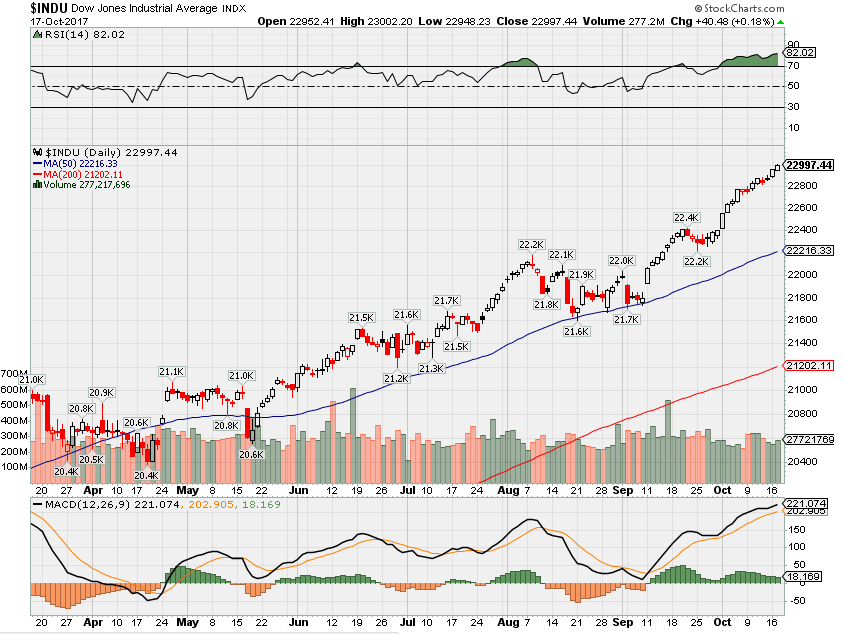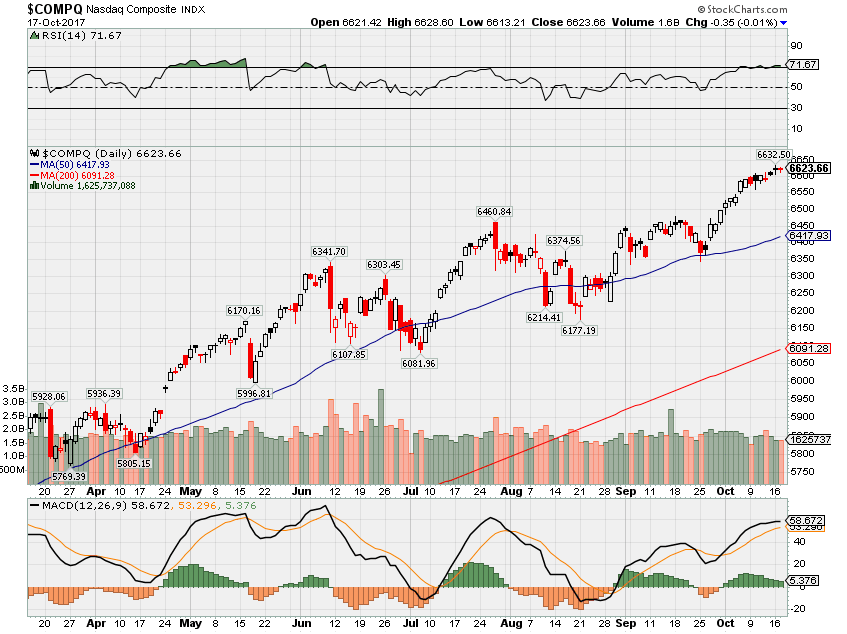HI Financial Services Commentary 10-17-2017
You Tube Video: https://youtu.be/pgQCzcHVtf4
What do you want to talk about today?
Our current stock market movement – Are we going to pull back this time?
Not necessarily as we are testing the 23,000 on the DJIA
Looks like we going to have a strong earnings season
What happening this week and why?
Empire 30.2 vs est 21
Import .3 vs est .3
Export 1.0 vs est .7
Capacity Utilization 76.0 vs est 76.1
Industrial Production .3 vs est .2
Where will our markets end this week?
Higher
DJIA – Overbought bullish
SPX – Overbought Bullsih
COMP – Bullish overbought
Where Will the SPX end October 2017?
10-17-2017 +2.0%
10-10-2017 +2.0%
10-03-2017 +1.0%
09-26-2017 +0.5
What is on tap for the rest of the week?=
Earnings:
Tues: CXS, GS, HOG, MS, CREE, IBM
Wed: ABT, SVU, USB, AA, AXP, KMI, EBAY, VMI
Thur: BK, KEY, NUE, PM, VZ, TACO, ETFC, ISRG, PYPL, WDFC
Fri: BHGE, HON, GE, SLB, PG
Econ Reports:
Tues: Import, Export, Capacity Utilization, Industrial Production, Net Long Term Tic Flows, Treasury Budget
Wed: MBA, Building Permits, Housing Starts. Fed Beige Book
Thur: Initial, Continuing Claims, Phil Fed
Fri: Existing Home Sales
Int’l:
Tues –
Wed – CN: GDP, Industrial Production, retail Sales
Thursday –
Friday-
Sunday – CN: Housing Price Index
How I am looking to trade?
Earnings List:
AA 10/18 AMC
AAPL 11/02 AMC
AOBC 11/30 est
BAC 10/13 BMO
BIDU 10/26
C 10/12 BMO
CLX 11/1 BMO
COST 10/5 AMC
DHI 11/09 BMO
DIS 11/9 AMC
F 10/26 BMO
FB 11/01 AMC
FCX 10/25 BMO
LUV 10/26 BMO
MO 10/26 BMO
MU 09/26 AMC
SODA 11/09 est
V 10/25 BMO
ZION 10/23 est
Questions???
www.myhurleyinvestment.com = Blogsite
customerservice@hurleyinvestments.com = Email
https://www.cnbc.com/2017/10/14/understanding-the-difference-between-the-imf-and-world-bank.html
Understanding the difference between the IMF and World Bank
Elizabeth Schulze | @eschulze9
Published 1:13 PM ET Sat, 14 Oct 2017
- The annual meetings of the International Monetary Fund and the World Bank are underway as policymakers from around the world gather in Washington.
- Both the IMF and the World Bank were conceived at the United Nations’ Bretton Woods Conference in July 1944.
The annual meetings of the International Monetary Fund and the World Bank are underway as policymakers from around the world gather in Washington to discuss the most pressing issues facing the global economy.
The IMF and the World Bank are closely linked – so close that their headquarters are across the street. So what’s the difference between the two? The answer goes back seven decades.
Both the IMF and the World Bank were conceived at the United Nations’ Bretton Woods Conference in July 1944. Top economic minds from 44 countries gathered at a hotel in New Hampshire to come up with a new framework for the international monetary system.
There was a general consensus that the old system of exchange rates and payments had failed, leading to the Great Depression, currency devaluations and the collapse of the gold standard.
“Economic cooperation was the main goal in everybody’s mind when they started to plan out the system during World War II,” said James Boughton, a senior fellow at the Centre for International Governance Innovation and former IMF historian.
Famed economist John Maynard Keynes, representing the United Kingdom at Bretton Woods, and Harry Dexter White, the U.S. Treasury representative, clashed over the terms of the new system. After three weeks, a deal was reached creating two distinct institutions: the International Monetary Fund and the International Bank for Reconstruction and Development, soon to be known as the World Bank.
“The idea behind the IMF structure was that countries would have less incentive to engage in competitive devaluations if there was an international institution that could provide short-term financing for balance of payment deficits,” said Benn Steil, a senior fellow at the Council on Foreign Relations and author of “The Battle of Bretton Woods.”
The IMF was tasked with overseeing a system of fixed exchange rates linking global currencies to the U.S. dollar, which was pegged to gold. The fund was also in charge of issuing short-term loans to countries struggling to meet their balance of payments.
The main goal of the World Bank was to give financial assistance to countries – mainly in Europe – that needed to rebuild after the war.
Experts say the roles of both institutions have shifted since their inception at Bretton Woods more than 70 years ago.
“The IMF is heavily involved in fighting crises around the world,” Steil said. “Neither the British nor the Americans ever envisioned the IMF doing that.”
Today the IMF keeps tabs on the global economy, provides technical assistance and training to implement economic policies and provides loans to member countries in need of financing. The World Bank, meanwhile, has focused primarily on development and reducing poverty.
Both institutions include 189 member countries and have vast operations around the world. The World Bank receives funding by issuing bonds to global investors, while the IMF is financed by quotas from member countries.
The institutions have their share of critics, in part because of the conditions attached to their loans. The IMF has come under fire for continuing to bail out countries like Greece that have struggled to clean up their finances. The World Bank has been accused of ignoring the social and environmental impacts of some its projects.
But Boughton said it’s premature for critics to write off the IMF and World Bank, adding their roles are likely to shift further as the global economy evolves.
“The basic mandates haven’t changed,” he said. “What’s changed is that the needs of countries across the world have evolved greatly.”
Even if the rally ends tomorrow, BofA says these two areas could be a life raft for investors
Stephanie Landsman | @stephlandsman
Published 5:00 PM ET Sun, 8 Oct 2017CNBC.com
Bank of America-Merrill Lynch is warning investors not to chase the rally.
Even though it’s predicting the end is near, the firm isn’t advocating a strategy which would push money to the sidelines.
“The market is trading quite elevated,” said Marc Pouey, BofA Merrill Lynch’s senior U.S. equity strategist, told CNBC’s “Futures Now” recently. “But I think underneath the surface there are quite a few opportunities out there.”
According to Pouey, there are two sectors which will likely be immune to a broader market downturn.
“Two of the glaring areas for me are financials and in health care which are both trading at a discount to the market here,” he said.
Pouey sees financials as a growth story.
“We’ve seen over 10 percent dividend growth in the space. They’re also buying back their stock very, very aggressively,” added Pouey. “They’re rewarding shareholders from that perspective.”
He made the case for health care based on the sector’s history.
“If you look back over the last three years or so, consistently — every single quarter — health care delivers top-line and bottom-line beats outside maybe a couple of quarters. They are really delivering the goods there,” said Pouey, noting that biotech is a shining area, too.
BofA’s S&P 500 Index year-end price target is 2450; that’s four percent below current levels. Pouey’s comments came as the index recorded its longest winning streak since 2013.
In a special note to CNBC, he called the environment a “sentiment driven market with the S&P 500 trading at a 17.8x forward price/earnings (PE) ratio, at cycle highs, and 1.5 multiple points above pre-election levels.”
As for market risks, the biggest issue is the lack of one.
“Near-term, there probably aren’t many risks, which is maybe the biggest risk,” Pouey said.
One spot he particularly finds negative is small-cap stocks. Pouey urged investors to fade the rally that area — pointing out its forward PE is within just one percent of cycle highs.
https://www.cnbc.com/2017/09/27/5-foolproof-ways-to-build-wealth.html
5 foolproof ways to build wealth
Arielle O’Shea
8:00 PM ET Wed, 27 Sept 2017
Nerdwallet.comHere’s a question with an easy answer: Want to get rich?
Even if you’re not the type to chase wealth, you’d probably say yes to financial comfort. That feeling of not having to think about money — or the more typical reality, stress over it — is what we’re all really after.
Whether you ever get to breathe that sigh of relief depends not on the next lottery drawing or get-rich opportunity, but on a combination of your circumstances and your approach to managing your finances. Admittedly, some of those circumstances may be beyond your control. But how you approach the money you have — however limited it may be — is not.
Here are five virtually surefire ways to slowly build wealth.
1. Use your time wisely
Unlike leftovers or an unmowed lawn, unspent money actually gets better with time. Getting an early start on investing for retirement can be almost as valuable as shoveling a ton of money away. (Of course, those who are able to put the two together end up sitting on the real pot of gold.)
Let’s consider three people who have $10,000 a year to invest. The first — we’ll call her Strong-Start Sammy — begins investing that $10,000 at age 25 and continues for 10 years. The second person, Consistent Cathy, starts saving at age 35 but keeps it up until age 65 without skipping a beat. Finally, Perfect Penny one-ups them both by contributing that $10,000 every year from age 25 to age 65.
It’s not hard to figure out that Perfect Penny comes out on top here: She puts away more money over a longer time horizon. The curveball comes from Cathy, who saves $200,000 more than Sammy but ends up with a balance that is only about $35,000 higher.
For that, Sammy can thank — and Cathy can curse — compound interest. The longer your money has to grow, the more you end up with and the less you actually have to save — investment returns start to multiply over time and pick up the slack.
2. Spend less than you earn
You’ve heard people tell you to live within your means. They’re wrong. To really build wealth, you need to live below your means — preferably, about 15 percent below.
That’s about how much you should be saving for retirement each year (though it’s worth determining a more personalized goal by using a retirement calculator), which leaves us with some simple math: If you want to save that much, you need to spend that much less than you make.
While the math is easy, the commitment to spending less is not. It requires an ongoing value judgement: Is this purchase today more important than retirement tomorrow? If it isn’t, try to pass.
It also requires avoiding high-interest-rate debt, which can effectively wipe out any chance you have of saving enough — and almost always indicates you’re living too large for your budget.
3. Progressively raise the bar
If you can save early and consistently like Penny, you get lots of head pats.
The rest of us need a more reasonable approach: Start small with whatever you have to save, and then regularly increase that amount. Doing so once a year is great; more frequently is even better.
Getting a raise is a good time to do it, as is after you’ve paid off a large debt. Direct that extra money toward savings and you won’t miss it.
4. Use every advantage
Aside from the obvious benefit of saving for retirement — that eternal hammock at the end — there are ongoing benefits, too: If you use the right accounts, you can lap up free money and lower your taxes.
That free money comes if you’re fortunate enough to have an employer plan like a 401(k) that offers matching contributions. Those dollars are an instant return on your investment: If you contribute 6 percent of your salary, for example, your employer might kick in 3 percent … and now you’re saving 9 percent of your income.
The money you put into a 401(k) also reduces your taxable income for the year, lowering the taxes you pay. (You’re not actually avoiding taxes, just pushing them down the road, when you’ll pay taxes on distributions from the account in retirement.)
If you don’t have a 401(k), consider an individual retirement account. A traditional IRA has the same tax treatment as a standard 401(k) — tax break now, pay taxes later — while a Roth IRA works in the reverse: You don’t get a tax break now, but you also don’t pay taxes on retirement distributions. You can compare Roth and traditional IRAs to see which account makes sense for your situation.
5. Don’t try too hard
Can you stock-trade your way to retirement? Sure, but you could also sit back, relax and let mutual funds do the work — specifically low-cost index funds or exchange-traded funds, which track a benchmark index such as the Standard & Poor’s 500.
These funds are like baskets that hold small pieces of many different individual investments, which means you get instant diversification, lowering your risk but typically not your returns. Here’s a how-to guide to investing in index funds.
You can build a solid portfolio out of just four funds, and while you may not beat the market, you should be able to easily keep pace.




HI Financial Services Mid-Week 06-24-2014